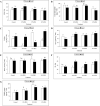Physiological responses and expression of sugar associated genes in faba bean (Vicia faba L.) exposed to osmotic stress
- PMID: 33627968
- PMCID: PMC7873190
- DOI: 10.1007/s12298-021-00935-1
Physiological responses and expression of sugar associated genes in faba bean (Vicia faba L.) exposed to osmotic stress
Abstract
Faba bean (Vicia faba L.) is the major food legume crop in Tunisia. However, its growth and yield is strongly affected by water-limited environments. In this study, osmotic stress exhibited a negative effect on Bachar and Badii cultivar. Nevertheless, the deteriorating effects of osmotic stress were relatively low on studied parameters of Bachar due to its better efficiency to reduce oxidative damage by increasing enzymatic activities such as catalase (CAT), superoxide dismutase (SOD) and ascorbate peroxidase (APX), accumulation of total chlorophyll (Chlt), soluble sugars and leaf relative water content (RWC). GC-MS analysis determined a total of 11 soluble carbohydrates induced by osmotic stress and differentially accumulated in the both cultivars. Bachar showed elevated levels of mannose, glucose, galactose, ribose, rhamnose and myo-inositol which might help to maintain osmotic adjustment, membranes and proteins protection from the damaging effect of reactive oxygen species. Sugar metabolism related genes (VfNINV3, VfPHS2, VfFRK4, VfHXK1, VfGPI1, VfSTP1.1, VfpGlcT1.1, VfSTP5.1, VfpGlcT1.2, VfSWEET2.1, VfVINV2, VfSUS1, VfPGM1, VfSUT1.1, VfGPT1, VfSPS1, VfSPP1, VfPHS1, VfSUT4.1 and VfTMT1.1) were differentially expressed in both cultivars demonstrating their important roles in sugar accumulation. Most of these genes were upregulated in the leaves of Bachar under moderate and severe stress, which could lead to increase glycolysis and tricarboxylic acid cycle in order to accelerate energy production, necessary to increase osmotic regulation and consequently enhancing the osmotic stress tolerance in that cultivar. Overall, sugars accumulation ability can be used as a useful indicator for the osmotic stress tolerant potential in faba bean breeding programs.
Supplementary information: The online version contains supplementary material available at (10.1007/s12298-021-00935-1).
Keywords: Faba bean; GC–MS; Gene expression; Osmotic stress; Sugar metabolism; qRT-PCR.
© Prof. H.S. Srivastava Foundation for Science and Society 2021.
Figures





References
-
- Abid G, Hessini K, Aouida M, Aroua I, Baudoin JP, Muhovski Y, Mergeai G, Sassi K, Machraoui M, Souissi F, Jebara M. Agro-physiological and biochemical responses of faba bean (Vicia faba L. var. ‘minor’) genotypes to water deficit stress. Biotechnol Agron Soc Environ. 2017;21:146–159.
-
- Ali HM, Siddiqui MH, Al-Whaibi MH, Basalah MO, Sakran AM, El-Zaidy M. Effect of proline and abscisic acid on the growth and physiological performance of faba bean under water stress. Pak J Bot. 2013;45:933–940.
-
- Aliche EB, Theeuwena TPJM, Oortwijn M, Visser RGF, van der Linden CG. Carbon partitioning mechanisms in POTATO under drought stress. Plant Physiol Biochem. 2020;146:211–219. - PubMed
-
- Amede T, Schubert S. Mechanisms of drought resistance in seed legumes. I.-Osmotic adjustment. Ethiop J Sci. 2003;26:37–46.
LinkOut - more resources
Full Text Sources
Other Literature Sources
Miscellaneous
